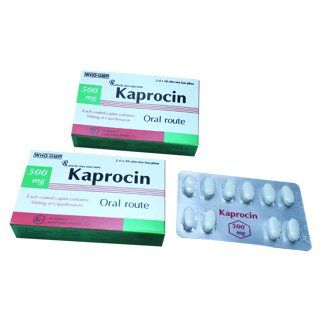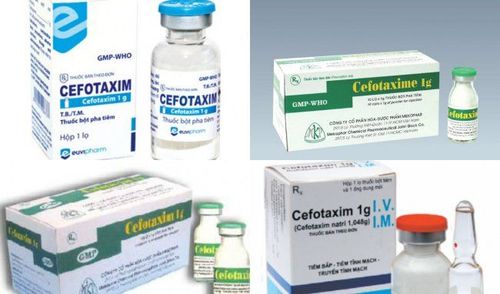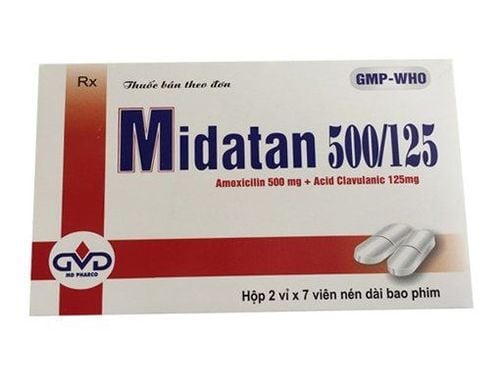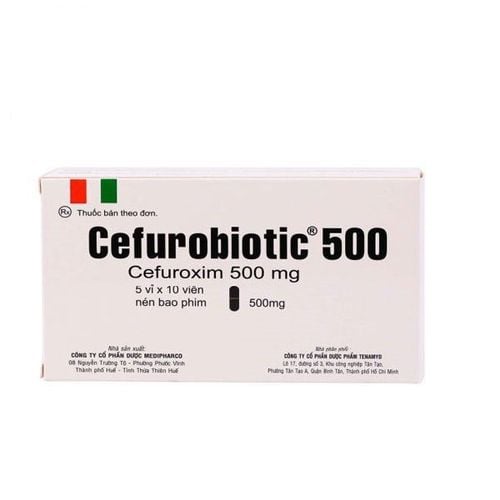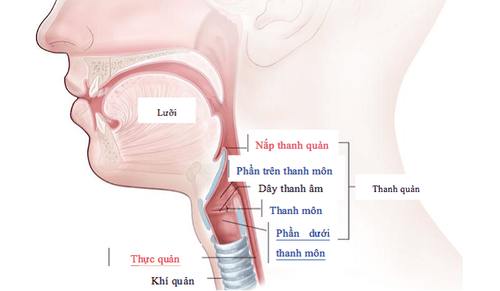This is an automatically translated article.
Kefodox is a medicine that is prepared for use in cases of respiratory tract infections, skin infections, urinary tract infections. Kefodox contains the antibiotic cefpodoxime as the main ingredient. Dosage, usage and notes when using Kefodox will be in the article below.
1. What is Kefodox?
What is Kefodox? Kedofox is an antibiotic with the main ingredient Cefpodoxime, used in the treatment of respiratory tract infections, pneumonia, gonococcal infections, skin and skin structure infections. With the dosage form of film-coated tablets, Keofodox is used orally, the content of Cefpodoxime in the drug can be 100mg or 200mg depending on the way of production of pharmaceutical companies.
2. Uses of the drug Kefodox
The main use of Kefodox is antibacterial, killing bacteria based on the main active ingredient Cefpodoxime.Cefpodoxime belongs to the 3rd generation Cephalosporin group with a broad antibacterial spectrum including Gram-positive cocci, streptococci and even Gram-negative bacteria. In countries with low rates of antibiotic resistance in the world, this antibiotic has been studied for its high resistance to attacks by beta-lactamases produced by Gram-negative and positive bacteria.
Cefpodoxime has the effect of acylating the membrane-bound transpeptidase enzymes of bacteria; this results in the crosslinking from the bacterial peptidoglycan chains being broken, so that the bacterial cell wall becomes less stable.
Regarding the antibacterial spectrum, Kefodox has antibacterial activity against Gram-negative and positive strains, especially stable to beta-lactamase. The antibacterial spectrum of Kefodox includes Staphylococcus aureus with the exception of methicillin-resistant Staphylococci, Streptococcus pneumoniae, Streptoccocus pyogenes, Streptococcus agalactiae, and Streptococcus spp. Gram-negative bacteria sensitive to Kefodox include strains of beta-lactamase-producing and non-beta-lactamase-producing bacteria: H. influenzae, Moraxella catarrhalis, H. para-influenzae, Neisseria gonorrhoea, Neisseria meningitidis, E. coli, Proteus vulgaris, Providencia rettgeri, Klebsiella pneumoniae, Citrobacter diversus. Kefodox is also effective against Peptostreptococcus spp.
Kefodox drug is well absorbed in the gastrointestinal tract after the patient takes the drug. At a dose of 100 mg, mean plasma concentrations of 1.4 mcg/mL can be achieved within 2 hours of dosing. 40% of an oral dose is bound to plasma proteins. The plasma half-life of Kefodox is 2.8 hours.
Regarding the extent of elimination, Kefodox drug is eliminated unchanged by the kidneys, 33% is eliminated mainly in the urine.
3. Indications for taking Kefodox
Kefodox antibiotic with the dosage form of film-coated tablets with two strengths of 100mg and 200mg is indicated in the following cases:
Treatment of respiratory tract infections: acute otitis media, sinusitis, inflammation tonsillitis, pharyngitis Treatment of community-acquired pneumonia Treatment of uncomplicated gonococcal infections Treatment of uncomplicated urinary tract infections Treatment of skin and skin structure infections
4. Contraindications to the use of Kefodox
Kefodox drug belongs to the 3rd generation Cephalosporin antibiotic group, so this drug is contraindicated when the patient has a history of hypersensitivity, allergy to the previous Cephalosporin antibiotic group.
5. Dosage & how to take Kefodox
How to take Kefodox
Kefodox is taken orally, well absorbed from the gastrointestinal tract and is not affected by food.
Dosage of Kefodox in adults
Upper respiratory tract infections: 100mg/time, 1 time every 12 hours, dose for 10 days. Community-acquired acute pneumonia : 200mg/time, once every 12 hours, dose for 14 days Uncomplicated gonococcal infection: single dose 200mg Uncomplicated urinary tract infection: 100mg/time, 12 hours orally 1 times, dose for 7 days. Skin infections and skin structure infections: 400mg/time, once every 12 hours, dose from 7-14 days. Dosage of Kefodox in children
Acute otitis media: 10 mg/kg body weight/day (maximum dose 400 mg/day divided into 2 oral doses), dose for 10 days. Tonsillitis and pharyngitis: 10 mg/kg body weight/day (maximum dose 200 mg/day divided into 2 oral doses), dose for 10 days. In patients with renal impairment, cefpodoxime should be administered with a 24-hour interval between doses. For patients with hepatic impairment receiving Kefodox for the treatment of bacterial infections, no dose adjustment is required.
6. Kefodox side effects
Kefodox is one of the antibiotics whose side effects are reported to be mild and almost transient. Some side effects when taking Kefodox are listed as follows
Digestive system: Diarrhea, nausea, vomiting, abdominal pain, colitis Mild headache Rare reactions are dizziness, rash, itching, thrombocytopenia, thrombocytosis, eosinophilia.
7. Notes when using Kefodox
Note when using Kefodox drug as follows:
For patients with kidney failure, liver failure, kidney and liver function should be checked regularly during the use of the drug. When Kefodox is used with antacids or H2 inhibitors, the plasma concentration of the drug will decrease by about 30% and affect the bioavailability of Kefodox. When using Kefodox, the direct Coomb test on the patient will be positive. Store Kefodox in a cool place, away from sunlight. In summary, Kefodox is an antibiotic belonging to the 3rd generation Cephalosporin group. Kefodox is available in two strengths, 100mg and 200mg, made in the form of film-coated tablets and taken orally. Kefodox is used in the treatment of respiratory, urinary and skin infections under the prescription of a specialist.
Follow Vinmec International General Hospital website to get more health, nutrition and beauty information to protect the health of yourself and your loved ones in your family.




